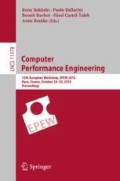Abstract
We consider a closed network of queues with external signals. These signals trigger customer between queues and they arrive following a rate which depends on the number of active customers in the station. We consider three types of stations: they may have one server, an infinite number of servers or no servers at all. In that case, the customers behave like inert customers and they only react to signal. We prove that, under irreducibility conditions, such a network has a stationary distribution which is multiplicative. As the network is finite, all the states are not reachable and the distribution is known up to a normalization constant. To avoid the computation of this constant, we also prove a mean value analysis algorithm which allows to determine the average queue size and the average waiting time without computing the probabilities. We also present some extensions of the model.
Access this chapter
Tax calculation will be finalised at checkout
Purchases are for personal use only
References
Balsamo, S., Harrison, P.G., Marin, A.: A unifying approach to product-forms in networks with finite capacity constraints. In: Misra, V., Barford, P., Squillante, M.S. (eds.) SIGMETRICS 2010, Proceedings of the 2010 ACM SIGMETRICS International Conference on Measurement and Modeling of Computer Systems, pp. 25–36. ACM, New York (2010)
Bolch, G., Greiner, S., De Meer, H., Trivedi, K.: Queueing Networks and Markov Chains. Wiley, Hoboken (1998)
Chao, X., Miyazawa, M., Pinedo, M.: Queueing Networks: Customers, Signals and Product Form Solutions. Wiley, Hoboken (1999)
Dao Thi, T.H., Fourneau, J.M.: Stochastic automata networks with master/slave synchronization: product form and tensor. In: Al-Begain, K., Fiems, D., Horváth, G. (eds.) ASMTA 2009. LNCS, vol. 5513, pp. 279–293. Springer, Heidelberg (2009). https://doi.org/10.1007/978-3-642-02205-0_20
Do, T.V.: An initiative for a classified bibliography on G-networks. Perform. Eval. 68(4), 385–394 (2011)
Fourneau, J.M.: Closed G-networks with resets: product form solution. In: Fourth International Conference on the Quantitative Evaluation of Systems (QEST 2007), Edinburgh, UK, pp. 287–296. IEEE Computer Society (2007)
Fourneau, J.-M.: Product form steady-state distribution for stochastic automata networks with domino synchronizations. In: Thomas, N., Juiz, C. (eds.) EPEW 2008. LNCS, vol. 5261, pp. 110–124. Springer, Heidelberg (2008). https://doi.org/10.1007/978-3-540-87412-6_9
Fourneau, J.M., Kloul, L., Quessette, F.: Multiple class G-networks with iterated deletions. Perform. Eval. 42(1), 1–20 (2000)
Fourneau, J.M., Quessette, F.: Computing the steady-state distribution of G-networks with synchronized partial flushing. In: Levi, A., Savaş, E., Yenigün, H., Balcısoy, S., Saygın, Y. (eds.) ISCIS 2006. LNCS, vol. 4263, pp. 887–896. Springer, Heidelberg (2006). https://doi.org/10.1007/11902140_92
Fourneau, J.M., Marin, A., Balsamo, S.: Modeling energy packets networks in the presence of failures. In: 24th IEEE International Symposium on Modeling, Analysis and Simulation of Computer and Telecommunication Systems, MASCOTS, London, United Kingdom, pp. 144–153. IEEE Computer Society (2016)
Gelenbe, E.: Product-form queuing networks with negative and positive customers. J. Appl. Prob. 28, 656–663 (1991)
Gelenbe, E.: G-networks with instantaneous customer movement. J. Appl. Prob. 30(3), 742–748 (1993)
Gelenbe, E.: G-networks: an unifying model for queuing networks and neural networks. Ann. Oper. Res. 48(1–4), 433–461 (1994)
Gelenbe, E.: Energy packet networks: ICT based energy allocation and storage. In: Rodrigues, J.J.P.C., Zhou, L., Chen, M., Kailas, A. (eds.) GreeNets 2011. LNICST, vol. 51, pp. 186–195. Springer, Heidelberg (2012). https://doi.org/10.1007/978-3-642-33368-2_16
Gelenbe, E.: A sensor node with energy harvesting. SIGMETRICS Perform. Eval. Rev. 42(2), 37–39 (2014)
Gelenbe, E., Ceran, E.T.: Energy packet networks with energy harvesting. IEEE Access 4, 1321–1331 (2016)
Gelenbe, E., Ceran, E.T.: Central or distributed energy storage for processors with energy harvesting. In: 2015 Sustainable Internet and ICT for Sustainability, SustainIT, pp. 1–3. IEEE (2015)
Gelenbe, E., Marin, A.: Interconnected wireless sensors with energy harvesting. In: Gribaudo, M., Manini, D., Remke, A. (eds.) ASMTA 2015. LNCS, vol. 9081, pp. 87–99. Springer, Cham (2015). https://doi.org/10.1007/978-3-319-18579-8_7
Harrison, P.G.: Compositional reversed Markov processes, with applications to G-networks. Perform. Eval. 57(3), 379–408 (2004)
Harrison, P.G., Patel, N.M.: Performance Modelling of Communication Networks and Computer Architectures. Addison-Wesley, Boston (1993)
Harrison, P.: Turning back time in Markovian process algebra. Theor. Comput. Sci. 290(3), 1947–1986 (2003)
Marin, A., Balsamo, S., Fourneau, J.: LB-networks: a model for dynamic load balancing in queueing networks. Perform. Eval. 115, 38–53 (2017)
Reiser, M., Lavenberg, S.S.: Mean-value analysis of closed multichain queuing networks. J. ACM 27(2), 313–322 (1980)
Takahashi, R., Takuno, T., Hikihara, T.: Estimation of power packet transfer properties on indoor power line channel. Energies 5(7), 2141 (2012)
Author information
Authors and Affiliations
Corresponding author
Editor information
Editors and Affiliations
Appendix: Proof of Theorem 1
Appendix: Proof of Theorem 1
Consider again the global balance equation at steady-state.
Divide both sides by \(\pi (\varvec{x}) \) and take into account the multiplicative solution proposed in Eq. 1. As the probability depends on the type of station, we have to decompose the summation into three parts, based on the set of stations we consider. We also notice that \(1_{x_i + 1 >0} =1\) and that \(x_i 1_{x_i>0}= x_i\) and we simplify some terms.
We exchange the role of indices i and j in all the terms of the r.h.s. and we factorize the terms (\(1+4+7+10+13\)), (\(2+5+8+11+14\)), (\(3+6+9+12+15\)):
The first and second term of the l.h.s. cancel with the first and second term of the r.h.s. due to the first flow equation (i.e. Eq. 2). It remains:
And this last equation is equivalent to the second flow equation for station in \({\mathcal{{Z}}}\) (i.e. Eq. 3). And the proof is complete. \(\square \)
Rights and permissions
Copyright information
© 2018 Springer Nature Switzerland AG
About this paper
Cite this paper
Fourneau, JM. (2018). Mean Value Analysis of Closed G-Networks with Signals. In: Bakhshi, R., Ballarini, P., Barbot, B., Castel-Taleb, H., Remke, A. (eds) Computer Performance Engineering. EPEW 2018. Lecture Notes in Computer Science(), vol 11178. Springer, Cham. https://doi.org/10.1007/978-3-030-02227-3_4
Download citation
DOI: https://doi.org/10.1007/978-3-030-02227-3_4
Published:
Publisher Name: Springer, Cham
Print ISBN: 978-3-030-02226-6
Online ISBN: 978-3-030-02227-3
eBook Packages: Computer ScienceComputer Science (R0)

